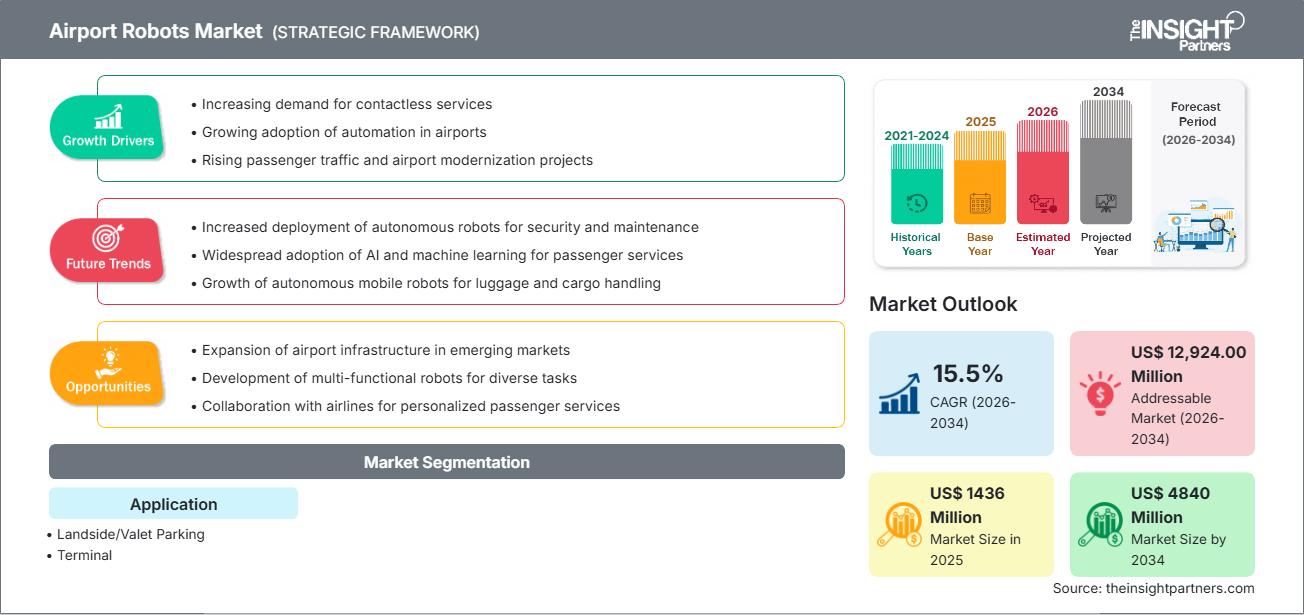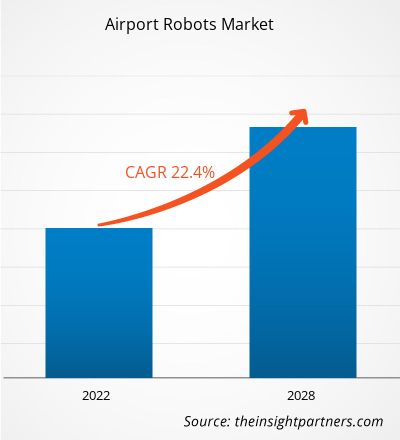Es wird erwartet, dass der Markt für Flughafenroboter von 1436 Millionen US-Dollar im Jahr 2025 auf 4840 Millionen US-Dollar im Jahr 2034 anwachsen wird, was einer durchschnittlichen jährlichen Wachstumsrate (CAGR) von 15,5 % im Prognosezeitraum (2026–2034) entspricht.
Marktanalyse für Flughafenroboter
Die zunehmende Automatisierung an Flughäfen, das wachsende Sicherheitsbewusstsein, der Kostendruck beim Personal und die steigenden Ansprüche an ein besseres Passagiererlebnis werden das Wachstum des Marktes für Flughafenroboter rasant vorantreiben. Flughäfen setzen vermehrt Serviceroboter für Passagierbetreuung, Reinigung, Gepäckabfertigung und sogar Sicherheitskontrollen ein, um die Abhängigkeit von menschlichen Arbeitskräften zu reduzieren und reibungslose Arbeitsabläufe zu gewährleisten. Die Integration von KI, Computer Vision, Gesichtserkennung und verbesserten Sensoren beschleunigt dieses Wachstum zusätzlich.
Zudem treiben starke Investitionen in die Flughafen-Infrastruktur weltweit, insbesondere in Schwellenländern, zusammen mit Modernisierungsplänen der Regierungen die Nachfrage weiter an. Roboter verbessern nicht nur die betriebliche Effizienz, sondern tragen auch zu mehr Sicherheit und Hygiene bei, was in einer Welt nach der COVID-19-Pandemie noch wichtiger geworden ist.
Marktübersicht Flughafenroboter
Flughafenroboter sind spezialisierte, autonome oder teilautonome Robotersysteme, die in Flughäfen eingesetzt werden und Aufgaben übernehmen, die von der Passagierführung über Sicherheitskontrollen, Gepäckabfertigung und Reinigung bis hin zu verschiedenen anderen betrieblichen Funktionen reichen. Diese Roboter tragen zur Automatisierung vieler sich wiederholender und ressourcenintensiver Prozesse bei, steigern die Effizienz der Dienstleistungen und reduzieren dadurch Personalaufwand und Betriebsrisiken.
Angesichts steigender Passagierzahlen und der Erwartung eines kontaktlosen, reibungslosen Flughafenerlebnisses spielen diese Robotersysteme eine wichtige Rolle bei der Modernisierung des Flughafenbetriebs. Ihr Einsatz umfasst sowohl den Bereich für Reisende im Kundenkontakt, wie Informationskioske und Wegweiser, als auch den Back-End-Bereich, wie Reinigung, Überwachung und Logistik.
Passen Sie diesen Bericht Ihren Anforderungen an.
Sie erhalten eine kostenlose Anpassung aller Berichte – einschließlich Teilen dieses Berichts, Länderanalysen und Excel-Datenpaketen – sowie attraktive Angebote und Rabatte für Start-ups und Universitäten.
Markt für Flughafenroboter: Strategische Einblicke

-
Ermitteln Sie die wichtigsten Markttrends dieses Berichts.Diese KOSTENLOSE Probe beinhaltet eine Datenanalyse, die von Markttrends bis hin zu Schätzungen und Prognosen reicht.
Markttreiber und Chancen für Flughafenroboter
Markttreiber:
- Sicherheitsautomatisierung & Bedrohungserkennung: Die Zunahme von Sicherheitsbedrohungen veranlasst Flughäfen dazu, Roboter einzusetzen, die mit Sensoren, Kameras und Gesichtserkennung ausgestattet sind, um Menschenmengen zu überwachen, Anomalien zu erkennen und nach Schmuggelware zu suchen.
- Erfordernisse der betrieblichen Effizienz: Flughäfen stehen unter ständigem Druck, die Arbeitskosten zu senken und den Betrieb zu optimieren; Roboter können Aufgaben unermüdlich erledigen und so die Abhängigkeit von manuellen Arbeitskräften bei Reinigung, Gepäckabfertigung und Überwachung verringern.
- Infrastructure Expansion & Modernization: Many governments are investing in building or expanding airports, presenting opportunities to integrate robotics early in airport design. For example, The Insight Partners report notes that new airport construction in countries like China and India is a significant growth lever.
Market Opportunities:
- Growth in Emerging Markets: Fast development and an increase in airport capacity in emerging economies provide a fertile ground for the deployment of robots.
- AI & Vision Integration: Using AI for navigation, voice interaction, and crowd analytics can make airport robots more intelligent and increase their utility for passenger-facing roles.
- Service Innovation: There is potential to expand use-cases, e.g., multilingual passenger assistance, autonomous baggage tugging, cleaning, and autonomous valet‑parking robots.
- Partnerships with Robotics OEMs: Airports can partner with robotics manufacturers and AI firms to co-develop tailor-made robot solutions optimized for their layouts, passenger profiles, and regulatory requirements.
Airport Robots Market Report Segmentation Analysis
The segmentation below follows the structure typically used in The Insight Partners’ analysis:
By Application:
- Landside / Valet Parking
- Terminal
By Geography:
- North America
- Europe
- Asia Pacific
- South & Central America
- Middle East & Africa
Airport Robots Market Regional Insights
The regional trends and factors influencing the Airport Robots Market throughout the forecast period have been thoroughly explained by the analysts at The Insight Partners. This section also discusses Airport Robots Market segments and geography across North America, Europe, Asia Pacific, Middle East and Africa, and South and Central America.
Airport Robots Market Report Scope
| Report Attribute | Details |
|---|---|
| Market size in 2025 | US$ 1436 Million |
| Market Size by 2034 | US$ 4840 Million |
| Global CAGR (2026 - 2034) | ?15.5% |
| Historical Data | 2021-2024 |
| Forecast period | 2026-2034 |
| Segments Covered |
By Application
|
| Regions and Countries Covered |
North America
|
| Market leaders and key company profiles |
|
Airport Robots Market Players Density: Understanding Its Impact on Business Dynamics
The Airport Robots Market is growing rapidly, driven by increasing end-user demand due to factors such as evolving consumer preferences, technological advancements, and greater awareness of the product's benefits. As demand rises, businesses are expanding their offerings, innovating to meet consumer needs, and capitalizing on emerging trends, which further fuels market growth.

- Get the Airport Robots Market top key players overview
Airport Robots Market Share Analysis by Geography
The report by The Insight Partners provides a regional breakdown to show how demand varies across different geographies:
North America
- Market Share & Importance: Historically leading in adoption due to strong aviation infrastructure, high security standards, and greater per‑capita spending on technology.
- Key Drivers: Regulatory compliance, labor cost pressures, and integration of robotics in passenger-facing and back-end operations.
Europe
- Market Share & Importance: Strong presence due to advanced airports and high safety and regulatory standards.
- Key Drivers: Focus on automation, sustainability, and efficiency in airport operations.
Asia Pacific
- Growth Trajectory: Expected to be a high-growth region, supported by rapid airport infrastructure development, strong passenger growth, and favorable government policies.
- Trends: Adoption of AI-enabled robots for passenger assistance, security, and cleaning; increasing collaborations with robotics companies.
South & Central America
- Market Potential: Growing aviation sector; potential for robotics adoption as newer airports are built or upgraded.
Middle East & Africa
- Opportunities: Ambitious airport expansion plans; increasing interest in advanced airport technologies for handling large passenger volumes and security.
Airport Robots Market Players Density: Understanding Its Impact on Business Dynamics
Competitive Strategies Observed:
- Partnerships between airports and robotics OEMs to co-create customized robots.
- The development of more autonomous and AI-driven robots that maximize value while minimizing intervention.
- Emphasis on interoperability: integrating robots with airport management systems, security protocols, and passenger data systems.
- Emphasize the reliability of robots, battery life, and safety certifications to meet strict aviation regulations.
Opportunities & Strategic Moves:
- Vendors can partner with governments to tap into airport modernization programs.
- Co-developing multilingual, passenger-facing robots to improve customer experience and service differentiation.
- Investing in R&D to reduce robot costs (hardware + software) to make deployments economically viable even for smaller airports.
Key Players of the Market:
- YUJIN ROBOT Co., Ltd.
- Avidbots Corp.
- CYBERDYNE INC.
- SoftBank Robotics
- Stanley Robotics SAS
- SITA
- ABB Ltd
- ECA Group
- LG Electronics
Other players of the market analyzed during the research:
- Universal Robots A/S
- Siemens AG
- Thales Group
- Vanderlande Industries
- Boston Dynamics
- Honeywell International Inc.
- KUKA AG
- BlueBotics SA
- UVD Robots
Airport Robots Market News and Recent Developments
- The Insight Partners report notes rising interest and deployment of security robots with facial recognition and remote sensing capabilities across several airports.
- Stanley Robotics has been operating autonomous valet robot systems in airport parking lots, freeing up ground space and increasing efficiency.
- Flughäfen in Schwellenländern (z. B. in Asien) investieren zunehmend in Passagierassistenz- und Reinigungsroboter, angetrieben sowohl durch Kapazitätserweiterungen als auch durch den Bedarf an kontaktlosen Dienstleistungen.
- OEMs entwickeln Robotersysteme der nächsten Generation mit verbesserter Akkulaufzeit, besserer KI-Navigation und multimodalen Interaktionen (Sprache + Berührung), um den unterschiedlichen Bedürfnissen der Passagiere gerecht zu werden.
Marktbericht zu Flughafenrobotern: Abdeckung und Ergebnisse
Der Bericht „Flughafenrobotermarkt – Prognose bis 2034“ von The Insight Partners umfasst Folgendes:
- Globale und regionale Marktgröße und Prognosen (2021–2034)
- Marktdynamik: Treiber, Hemmnisse, Chancen und Trends
- Folgenabschätzung von COVID-19 für die Einführung von Flughafenrobotik
- Segmentierungsanalyse: nach Typ, Anwendung, Endnutzer, Geografie
- PEST-Analyse (politische, wirtschaftliche, soziale und technologische Faktoren) und SWOT-Analyse
- Wettbewerbsumfeld: Marktkonzentration, Heatmap der führenden Akteure, Strategien
- Detaillierte Unternehmensprofile der wichtigsten Akteure: SITA, SoftBank Robotics, Stanley Robotics, ABB, LG Electronics, CYBERDYNE, Yujin Robot usw.
- Historische Analyse (2 Jahre), Basisjahr, Prognose (7 Jahre) mit CAGR
- PEST- und SWOT-Analyse
- Marktgröße Wert/Volumen – Global, Regional, Land
- Branchen- und Wettbewerbslandschaft
- Excel-Datensatz
Aktuelle Berichte
Erfahrungsberichte
Grund zum Kauf
- Fundierte Entscheidungsfindung
- Marktdynamik verstehen
- Wettbewerbsanalyse
- Kundeneinblicke
- Marktprognosen
- Risikominimierung
- Strategische Planung
- Investitionsbegründung
- Identifizierung neuer Märkte
- Verbesserung von Marketingstrategien
- Steigerung der Betriebseffizienz
- Anpassung an regulatorische Trends






















 Kostenlose Probe anfordern für - Markt für Flughafenroboter
Kostenlose Probe anfordern für - Markt für Flughafenroboter